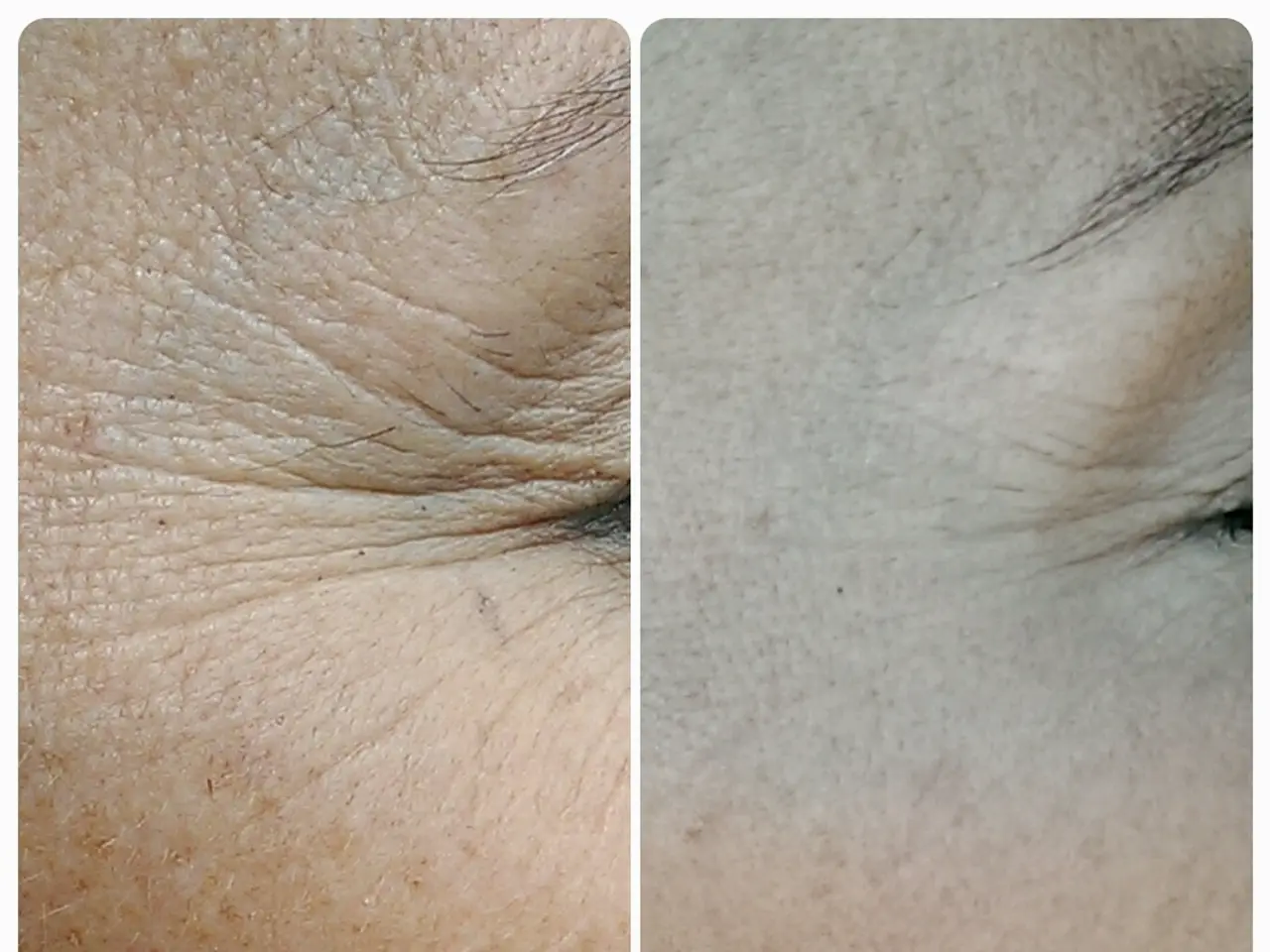Psoriasis Inverse vs. Intertrigo: Differences in Symptoms and Characteristics
**News Article: Inverse Psoriasis and Intertrigo: Understanding the Differences and Treatment Options**
In the realm of skin conditions, inverse psoriasis and intertrigo share some similarities in their locations but have distinct causes and treatment methods. Both affect areas where skin folds, such as the armpits, groin, and under the breasts, and can cause discomfort and discoloration.
Inverse psoriasis, an autoimmune condition, occurs when the immune system mistakenly attacks healthy skin, causing inflammation. This type of psoriasis affects the body's skin folds and is characterised by smooth, shiny, and often moist lesions without typical psoriasis scales. These lesions can appear bright red, purplish, or brown on light skin tones, while on skin of colour, they may appear purple-ish or brown [1][3][5].
On the other hand, intertrigo is caused by mechanical irritation from skin rubbing together in folds, trapping moisture. This leads to skin breakdown and can result in secondary bacterial or fungal infections, especially candidal intertrigo caused by the *Candida* fungus [1]. The condition typically presents as a red, irritated, sometimes moist rash in skin folds, possibly with fissuring or peeling, and may appear discolored if infected [1].
Treatment for both conditions depends on the underlying cause. For inverse psoriasis, options include topical creams with low-potency corticosteroids, vitamin D analogs, tar-based solutions, calcineurin inhibitors, and systemic medications such as biologics, oral retinoids, methotrexate, and apremilast [1][3][5]. Intertrigo treatment may involve barrier creams to protect the skin, antifungal or antibacterial creams if an infection is present, and topical corticosteroids used cautiously to reduce inflammation but with care to avoid worsening the infection [1]. In severe cases of intertrigo, oral antifungals or antibiotics may be prescribed [1].
While there is currently no cure for inverse psoriasis, it will have flare-ups and periods of remission. Inverse psoriasis may be mistaken for fungal infections due to its smooth appearance with little or no scaling. On the other hand, intertrigo may resolve permanently with treatment and management, especially if the underlying cause, such as excessive moisture or friction, is addressed [1].
Both conditions can be managed effectively with home management strategies such as maintaining a moderate weight, drying out moist areas of skin, drying and separating skin folds, wearing loose clothing, regularly exercising, and thorough bathing and drying. Individuals are advised to seek medical attention if more skin areas become affected, the condition does not improve with treatments or home care, they experience pain, discomfort, or difficulty performing daily activities, or they experience problems in the joints [1].
In conclusion, understanding the differences between inverse psoriasis and intertrigo is crucial for proper diagnosis and treatment. While both conditions affect similar areas, they have distinct causes and treatment methods. Misdiagnosis can occur, especially with candidal infections complicating intertrigo and sometimes confusing it with inverse psoriasis. Effective management involves addressing the underlying cause, using appropriate treatments, and adhering to home management strategies.
[1] Mayo Clinic (2021). Inverse Psoriasis and Intertrigo: Causes, Symptoms, and Treatment. Retrieved from [https://www.mayoclinic.org/diseases-conditions/inverse-psoriasis/symptoms-causes/syc-20353441](https://www.mayoclinic.org/diseases-conditions/inverse-psoriasis/symptoms-causes/syc-20353441)
[3] American Academy of Dermatology (2021). Intertrigo. Retrieved from [https://www.aad.org/public/diseases/skin-infections/intertrigo](https://www.aad.org/public/diseases/skin-infections/intertrigo)
[5] National Psoriasis Foundation (2021). Inverse Psoriasis. Retrieved from [https://www.psoriasis.org/about-psoriasis/types/inverse-psoriasis](https://www.psoriasis.org/about-psoriasis/types/inverse-psoriasis)
- Recognizing the differences between inverse psoriasis and intertrigo is essential, as both autoimmune disorders and skin conditions affect similar areas but require distinct treatments.
- Switchers seeking help for skin-related issues must be aware that inverse psoriasis, an autoimmune disorder, is characterized by smooth, shiny, and often moist lesions, unlike the scaling common in other autoimmune disorders.
- In contrast, intertrigo, a condition caused by skin irritation from rubbing or moisture, typically presents as a red, irritated rash in skin folds.
- Naive seekers of medical treatment for chronic diseases like psoriasis and other autoimmune disorders might find relief in topical creams, systemic medications, or home management strategies.
- Managing conditions like inverse psoriasis and intertrigo often involves addressing the underlying causes, such as mental health, skin-care routines, and certain medical-conditions that contribute to skin conditions.
- Personas battling chronic diseases like psoriasis should take a proactive approach to their health-and-wellness, including maintaining a moderate weight, regular exercise, and proper skin-care.
- It is advisable for those dealing with persistent skin issues or experiencing discomfort, difficulties, or joint problems to consult with healthcare professionals for proper diagnosis and treatment.




